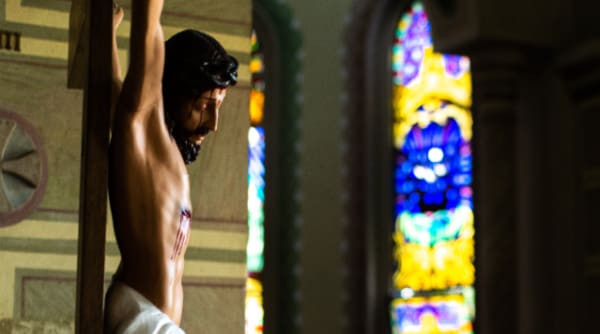We are all quite familiar with the seven capital sins: pride, greed, envy, wrath, lust, gluttony, and sloth. Perhaps we learned about them in a classroom setting; certainly we have encountered them in ourselves and others!
Today, I would like to invite each of us to do something we normally don’t do – to feel deeply the Father’s kindness toward us in our weaknesses and our repeated tendency towards sin. Then, with Jesus, we can allow ourselves to be curious about these inclinations that we experience.
As an accomplished sinner myself and as one who offers pastoral care to sinners, I find that we fallen humans tend to feel a great deal of shame and contempt around our weaknesses, our vulnerability to sin, and the details of our acting out. We tend to despise any part of ourselves that feels inclined to think or speak or act in one of these ways. Whether an inclination to numb out in slothfulness, to overeat, to compare ourselves with others and feel sadness, or to enter the realm of sexual fantasizing, we just wish that it would all go away. Shame incites us to see the broken pieces of our heart as worthless garbage to be incinerated, rather than as bearing the image of God and beckoning us back to the heart of the Father.
A deeper understanding of the capital sins – what they really are and why they are called “capital” in the first place – leads us to seek traces of God’s goodness even in those places of our heart that feel totally beyond his reach.
If we speak with greater accuracy, these seven impulses are not “sins” in the full and proper sense. They are tendencies or vulnerabilities in us. They are called “sins” because they come from sin and incline us toward sin. In Catholic theology, we speak of “concupiscence” as a wound in us, a strong inclination toward sinfulness that is part of the human experience as a result of the Fall of Adam and Eve. This wound of concupiscence is, of course, exacerbated by our own choices in life. The more we sin, the more we want to sin. The seven capital sins can then be understood as seven different ways that fallen human beings experience a strong inclination toward sin. We do not find it difficult to allow ourselves to indulge in any one of these seven inclinations. Jesus speaks about the wide gate and easy road that leads to destruction – in contrast to the narrow gate and difficult road that leads to life.
Indeed, we probably best know these tendencies as the “seven deadly sins” – because they easily become toxic, harmful, and deeply destructive. Unchecked, they rupture our relationships with God, others, and self, and ultimately lead toward death in every sense – physically, emotionally, and spiritually. Each of us is created in the image and likeness of a God who is love – an eternal communion of persons in glorious relationship. We innately understand just how destructive our acting out becomes – and the devil is all too eager to bury us in shame. His endgame is to tear away as many of us as he can and get us to agree to never ending isolation, misery, and torment.
But why are these seven tendencies called “capital sins”? The word “capital” comes from the Latin caput – which means “head,” but can also mean “source.” John Cassian and Gregory the Great reflect on how each of these impulses becomes a source of sinfulness in us – not sins in and of themselves, but, if unchecked, strong impulses that lead us down the road of perdition.
The thing is, the devil cannot create. He is not God. He can only use the good and beautiful things God has created in an attempt to lie and steal and destroy. Ignatius of Loyola refers to the devil as “the enemy of human nature.” He absolutely despises us. He hates the glory of God that shines in each of us. That is where he attacks the hardest – which in a backwards way teaches us an important lesson: if we look deeply into our hearts at the places where we experience the most intense attack in the form of the seven capital sins, there we will find God’s glory the most present. Why else would the devil attack us so intensely there?
In other words, at the core of each of these seven capital sins in us, we find amazingly good desires and needs that God has placed in the human heart. Yes, these seven tendencies can easily become sources of sinfulness that have great potential to lead us astray. But they can also be deeply helpful clues to lead us back to God!
That is where tender kindness, childlike wonder, and holy curiosity come in. Rather than shaming myself, I can start noticing what is happening in my heart. My anger is there whether I like it or not! Yes, I can allow it to leak out in aggression toward others or myself. But it can also be an invitation into the fullness of God’s truth and justice, and an awakening of my prophetic identity in Christ. In my envy I can notice the things my heart deeply aches for – often things the Lord deeply desires for me – but only if I am willing to allow myself to feel the heartache of longing and waiting. In my lust I can notice all kinds of desires and needs – to be desired and chosen, to be safe and secure, to be embraced, to be known and understood, or to be loved as I am, (notice that none of these is really about sex!). In my sloth I may discover much less “laziness” and much more shame and fear – an urge to hide and isolate and turn away when what I actually need is real relationships, in which I can be cared for precisely where I feel the weakest and most vulnerable.
Whatever capital sins we find to be our “personal favorites” are also very likely the places we will find the deepest and holiest longings of our hearts –places in which our loving Father desires us to experience our true dignity, meaning, and purpose as his beloved children. Each of us can become “disciples” – yes, in the sense of discipline, but even more so by allowing Jesus to help us become students of our own heart, which is created in the image and likeness of God and declared by him to be “very good.” If we open ourselves to that experience of authentic discipleship, the places of our deepest sorrow and struggle will become the very places that lead us back to the heart of the Father.
This post was originally published on AbideinLove.com and is reprinted here with permission.
Image courtesy of Unsplash.





